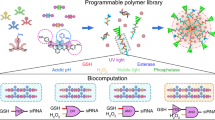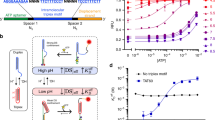Abstract
Clinical and field-portable diagnostic devices require the detection of atto- to zeptomoles of biological molecules rapidly, easily and at low cost, with stringent requirements in terms of robustness and reliability. Though a number of creative approaches to this difficult problem have been reported1,2,3,4,5,6,7,8,9, numerous unmet needs remain in the marketplace, particularly in resource-poor settings10,11,12. Using rational materials design, we investigated harnessing the amplification inherent in a radical chain polymerization reaction to detect molecular recognition. Polymerization-based amplification is shown to yield a macroscopically observable polymer, easily visible to the unaided eye, as a result of as few as ∼1,000 recognition events (10 zeptomoles). Design and synthesis of a dual-functional macromolecule that is capable both of selective recognition and of initiating a polymerization reaction was central to obtaining high sensitivity and eliminating the need for any detection equipment. Herein, we detail the design criteria that were used and compare our findings with those obtained using enzymatic amplification. Most excitingly, this new approach is general in that it is readily adaptable to facile detection at very low levels of specific biological interactions of any kind.
This is a preview of subscription content, access via your institution
Access options
Subscribe to this journal
Receive 12 print issues and online access
$259.00 per year
only $21.58 per issue
Buy this article
- Purchase on Springer Link
- Instant access to full article PDF
Prices may be subject to local taxes which are calculated during checkout




Similar content being viewed by others
References
Elghanian, R., Storhoff, J. J., Mucic, R. C., Letsinger, R. L. & Mirkin, C. A. Selective colorimetric detection of polynucleotides based on the distance-dependent optical properties of gold nanoparticles. Science 277, 1078–1081 (1997).
Nam, J.-M., Thaxton, C. S. & Mirkin, C. A. Nanoparticle-based bio-bar codes for the ultrasensitive detection of proteins. Science 301, 1884–1886 (2003).
Jenison, R., Yang, S., Haeberli, A. & Polisky, B. Interference-based detection of nucleic acid targets on optically coated silicon. Nature Biotechnol. 19, 62–65 (2001).
Sia, S. K., Linder, V., Parviz, B. A., Siegel, A. & Whitesides, G. M. An integrated approach to a portable and low-cost immunoassay for resource-poor settings. Angew. Chem. Int. Edn 43, 498–502 (2004).
Lee, H. J., Li, Y., Wark, A. W. & Corn, R. M. Enzymatically amplified SPR imaging detection of DNA by exonuclease III digestion of DNA microarrays. Anal. Chem. 77, 5096–5100 (2005).
Cooper, M. A. Label-free screening of bio-molecular interactions. Anal. Bioanal. Chem. 377, 834–842 (2003).
Fan, C., Plaxco, K. W. & Heeger, A. J. Biosensors based on binding-modulated donor–acceptor distances. Trends Biotechnol. 23, 186–192 (2005).
Cunin, F. et al. Biomolecular screening with encoded porous-silicon photonic crystals. Nature Mater. 1, 39–41 (2002).
Asher, S. A. et al. Photonic crystal carbohydrate sensors: low ionic strength sugar sensing. J. Am. Chem. Soc. 125, 3322–3329 (2003).
Mabey, D., Peeling, R. W., Ustianowski, A. & Perkins, M. D. Diagnostics for the developing world. Nature Rev. Microbiol. 2, 231–240 (2004).
Bell, J. Predicting disease using genomics. Nature 429, 453–456 (2004).
Darr, A. S. et al. Top ten biotechnologies for improving health in developing countries. Nature Genet. 32, 229–232 (2002).
Kloosterboer, J. G. Network formation by chain crosslinking photopolymerization and its applications in electronics. Adv. Polym. Sci. 84, 1–61 (1988).
Wilcheck, M., Bayer, E. A. & Livnah, O. Essentials of biorecognition: The (strept)avidin–biotin system as a model for protein–protein and protein–ligand interaction. Immunol. Lett. 103, 27–32 (2006).
Jenison, R., La, H., Haeberli, A., Ostroff, R. & Polisky, B. Silicon-based biosensors for rapid detection of protein or nucleic acid targets. Clin. Chem. 47, 1894–1900 (2001).
Jenison, R., Yang, S., Haeberli, A. & Polisky, B. Interference-based detection of nucleic acid targets on optically coated silicon. Nature Biotechnol. 19, 62–65 (2001).
Zhong, X. et al. Single-nucleotide polymorphism genotyping on optical thin-film biosensor chips. Proc. Natl Acad. Sci. USA 100, 11559–11564 (2003).
Mosbach, K. & Ramstrom, O. The emerging technique of molecular imprinting and its future impact on biotechnology. Nature Biotechnol. 14, 163–170 (1996).
Peppas, N. A., Hilt, J. Z., Khademhosseini, A. & Langer, R. Hydrogels in biology and medicine: from molecular principles to bionanotechnology. Adv. Mater. 18, 1345–1360 (2006).
O’Connor, N. A., Paisner, D. A., Huryn, D. & Shea, K. J. Screening of 5-HT1A receptor antagonists using molecularly imprinted polymers. J. Am. Chem. Soc. 129, 1680–1689 (2007).
Hawker, C. J., Bosman, A. W. & Harth, E. New polymer synthesis by nitroxide mediated living polymerizations. Chem. Rev. 101, 3661–3688 (2001).
Coessens, V., Pintauer, T. & Matyjaszewski, K. Functional polymers by atom transfer radical polymerization. Prog. Polym. Sci. 26, 337–377 (2001).
Guacher, G. et al. Block copolymer micelles: Preparation, characterization, and application in drug delivery. J. Control. Rel. 109, 169–188 (2005).
Staros, J. V., Wright, R. W. & Swingle, D. M. Enhancement by N-hydroxysulfosuccinimide of water-soluble carbodiimide-mediated coupling reactions. Anal. Biochem. 156, 220–222 (1986).
Green, N. M. A spectrophotometric assay for avidin and biotin based on binding of dyes by avidin. Biochem. J. 94, 23c–24c (1965).
Jayasena, S. D. Aptamers: An emerging class of molecules that rival antibodies in diagnostics. Clin. Chem. 45, 1628–1650 (1999).
Binz, H. K., Amstutz, P. & Pluckthun, A. Engineering novel binding proteins from nonimmunoglobulin domains. Nature Biotechnol. 23, 1257–1268 (2005).
Brandt, O. & Hoheisel, J. D. Peptide nucleic acids on microarray and other biosensors. Trends Biotechnol. 22, 617–622 (2004).
Liu, H. et al. A four-base paired genetic helix with expanded size. Science 302, 868–871 (2003).
Boder, E. T., Midelfort, K. S. & Wittrup, K. D. Directed evolution of antibody fragments with monovalent femtomolar antigen binding affinity. Proc. Natl Acad. Sci. 97, 10701–10705 (2000).
Acknowledgements
H.D.S. acknowledges support from the National Human Genome Research Institute (NSRA F32-HG003100) and the Burroughs Wellcome Fund (Career Award at the Scientific Interface). R.R.H., L.M.J., K.L.R. and C.N.B. acknowledge support from NSF SGER 0442047 and NIH R41 AI060057. Thin-film biosensors, buffers and enzymatic detection reagents were generously provided by Inverness Medical-Biostar.
Author information
Authors and Affiliations
Contributions
K.L.R., J.W.B. and C.N.B. came up with the concept, C.N.B., H.D.S. and R.J. designed the experiments, H.D.S., R.R.H. and L.M.J. performed the experiments and H.D.S., C.N.B. and R.J. wrote the paper.
Corresponding author
Supplementary information
Supplementary Information
Supplementary information and figures (PDF 114 kb)
Rights and permissions
About this article
Cite this article
Sikes, H., Hansen, R., Johnson, L. et al. Using polymeric materials to generate an amplified response to molecular recognition events. Nature Mater 7, 52–56 (2008). https://doi.org/10.1038/nmat2042
Received:
Accepted:
Published:
Issue Date:
DOI: https://doi.org/10.1038/nmat2042
This article is cited by
-
Dynamic display of biomolecular patterns through an elastic creasing instability of stimuli-responsive hydrogels
Nature Materials (2010)
-
Quantitative evaluation of oligonucleotide surface concentrations using polymerization-based amplification
Analytical and Bioanalytical Chemistry (2008)



